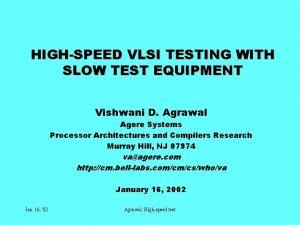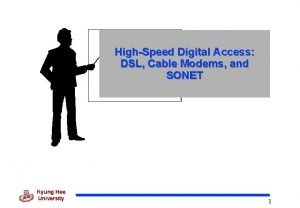The Design of a LowPower HighSpeed Phase Locked

- Slides: 1

The Design of a Low-Power High-Speed Phase Locked Loop Tiankuan Liu 1, Datao Gong 1, Suen Hou 2, Zhihua Liang 1, Chonghan Liu 1, Da-Shung Su 2, Ping-Kun Teng 2, Annie C. Xiang 1, Jingbo Ye 1 1 Department of Physics, Southern Methodist University, Dallas TX 75275, U. S. A. 2 Institute of Physics, Academia Sinica, Nangang 11529, Taipei, Taiwan liu@mail. physics. smu. edu Introduction Application Background: ATLAS Liquid Argon Calorimeter Optical Link Upgrade Present Upgrade Data rate per front-end board (FEB) (Gbps) 1. 6 100 Power consumption per Gbps (m. W) 1188 90 Silicon-on-Sapphire (So. S) CMOS technology • • Design Goals • High speed, low power, high quality inductors, no latch-up The radiation tolerance of a commercial 0. 25 µm So. S CMOS technology has been evaluated in the previous study Operation frequency: 4 ~ 5 GHz for data rate 8 ~ 10 Gbps Random jitter < 1 ps (RMS) Power consumption < 100 m. W • • Design PLL block diagram • • • VCO The PLL consists of a phase frequency detector (PFD), a charge pump, a low pass filter, a voltage controlled oscillator (VCO), and a divider (divide by 16). An LVDS receiver and a CML driver are used as the input and output interface. The divider consists of a CML divider (divide by 2), a CML to CMOS converter, and a CMOS divider (divide by 8). The LVDS receiver, the phase frequency detector (PFD), the charge pump, the pass filter, the CMOS divider, and the CML driver are shared with the 5 Gbps 16: 1 serializer. For details of these design blocks please see the poster “A 16: 1 serializer for data transmission at 5 Gbps ” presented by Dr. Datao Gong. The bandwidth of the low pass filter and the current of charge pump are programmable to suit different applications. The phase margin of the PLL is larger than 46°. VCO Type LC-based VCO Ring-oscillator based VCO Power Consumption Low High Frequency High Low Phase noise/jitter performance Good Bad Radiation sensitivity Small Large Tuning range Narrow Wide Chip area Large Small A NMOS or PMOS transistor with its source and drain tied together serves a varactor with monotonic C-V curve and large tuning range (Cmax/Cmin > 2). Cross-coupled transistors provides negative resistance, compensating the energy loss in the LC tank Decoupling capacitors are used to improve the noise performance PLL Layout The tuning range is 3. 79 – 5. 01 GHz at the typical corner and room temperature and varies less than 8% in all corners and temperature range. Start-up circuit Reference current source On-chip spiral inductors with a peak frequency of 5. 1 GHz. The Q factor is simulated to be 21. 2 at 5 GHz. CML Divider 1. 4 mm x 1. 7 mm The CML divider can work up to 5. 1 GHz at all corners and from -40 °C to 85 °C. Performances Acquisition Time Deterministic Jitter Random Jitter The phase noise of the VCO in the worst case The PLL tracks the input frequency after 9 µs. The jitter after 9 µs is less than 2 ps (peak). Conclusion Simulated results of the PLL Acknowledgments Status and Plan Tuning range (GHz) 3. 8 – 5. 1 • Power consumption of core PLL (m. W) Area (mm 2) 104 1. 4 x 1. 7 • Random Jitter from VCO (RMS, ps) <1 Deterministic jitter (peak-peak, ps) Acquisition time (μs) 2 9 • The random jitter due to the VCO’s phase noise, the dominant noise source, is less than 1 ps (RMS) from 10 k. Hz to 100 MHz. Fabrication: submitted on August 3, 2009; Chip delivery: November 17, 2009 Test: in lab test: December 15, 2009; Radiation test: February 15, 2010 Plan: apply this LC-based PLL and design a multi-channel 16: 1 serializer with each channel working around 10 Gbps in 2011 • Grant: US-ATLAS R&D program for the upgrade of the LHC and the US Department of Energy grant DE-FG 02 -04 ER 41299. • Peter Clarke, Jay Clementson, Yi Kang, Francis M. Rotella, John Sung, and Gary Wu from Peregrine Semiconductor Corporation for technical assistance. • Justin Ross at Southern Methodist University for setting up and maintaining the software environment. • Jasoslav Ban, Mauro Citterio, Christine Hu, Sachin Junnarkar, Valentino Liberali, Paulo Rodrigues Simoes Moreira, Mitch Newcomer, Quan Sun, Fukun Tang, and Carla Vacchi for technical assistance and reviewing of this design.

